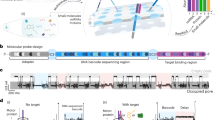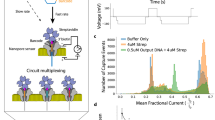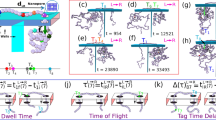Abstract
A major challenge in clinical diagnostics and environmental analysis is the difficulty in rapid and sensitive detection of multiple target molecules simultaneously (i.e., multiplexed detections). Our group has designed and synthesized a dendrimer-like DNA (DL-DNA) that is multivalent and anisotropic; using this unique DNA structure, we have developed a fluorescence-tagged nanobarcode system for multiplex detection. This nanobarcode system allows the rapid and sensitive detection of multiple pathogens simultaneously using the ratios of two different fluorescent dyes, green and red, with which different DL-DNAs are labeled. The key step of our nanobarcode model lies in the monodisperse preparation of DL-DNA. Two methods, solution phase and solid phase, are presented here. With slight modifications, this platform technology can also be extended to the multiplexed detection of RNA and proteins. This protocol can be completed in 2–5 d.
This is a preview of subscription content, access via your institution
Access options
Subscribe to this journal
Receive 12 print issues and online access
$259.00 per year
only $21.58 per issue
Buy this article
- Purchase on SpringerLink
- Instant access to full article PDF
Prices may be subject to local taxes which are calculated during checkout





Similar content being viewed by others
References
Li, Y. et al. Controlled assembly of dendrimer-like DNA. Nature Mater. 3, 38–42 (2004).
Li, Y., Cu, Y.T. & Luo, D. Multiplexed detection of pathogen DNA with DNA-based fluorescence nanobarcodes. Nature Biotechnol. 23, 885–889 (2005).
Li, Y. & Luo, D. Multiplexed molecular detection using encoded microparticles and nanoparticles. Exp. Rev. Mol. Diagn. (in press).
Seeman, N.C. & Kallenbach, N.R. Design of immobile nucleic acid junctions. Biophys. J. 44, 201–209 (1983).
Kallenbach, N.R., Ma, R.I. & Seeman, N.C. An immobile nucleic-acid junction constructed from oligonucleotides. Nature 305, 829–831 (1983).
Ma, R.I., Kallenbach, N.R., Sheardy, R.D., Petrillo, M.L. & Seeman, N.C. Three-arm nucleic acid junctions are flexible. Nucleic Acids Res. 14, 9745–9753 (1986).
Luo, D., Cu, Y.T., Li, Y. & Um, S.H. in Chapter 10, DNA Vaccines: Methods and Protocols (eds Saltzman, W.M., Shen, H. & Brandsma, J.L.) (Humana Press, New Jersey, 2006).
Seeman, N.C. Nucleic acid junctions and lattices. J. Theor. Biol. 99, 237–247 (1982).
Seeman, N.C. De novo design of sequences for nucleic acid structural engineering. J. Biomol. Struct. Dyn. 8, 573–581 (1990).
Acknowledgements
We wish to acknowledge USDA, Cornell Advanced Technology Centre for Biotechnology and the Cornell Nanobiotechnology Center (an STC Program of of the National Science Foundation under Agreement No. ECS-9876771) for financial support.
Author information
Authors and Affiliations
Corresponding author
Ethics declarations
Competing interests
The author, DL, is one of the founders of a company who licensed the technology from Cornell University.
Rights and permissions
About this article
Cite this article
Um, S., Lee, J., Kwon, S. et al. Dendrimer-like DNA-based fluorescence nanobarcodes. Nat Protoc 1, 995–1000 (2006). https://doi.org/10.1038/nprot.2006.141
Published:
Issue date:
DOI: https://doi.org/10.1038/nprot.2006.141
This article is cited by
-
Hybrid material of structural DNA with inorganic compound: synthesis, applications, and perspective
Nano Convergence (2020)
-
A novel fluorescent biosensor based on dendritic DNA nanostructure in combination with ligase reaction for ultrasensitive detection of DNA methylation
Journal of Nanobiotechnology (2019)
-
Fluorescence-coded DNA Nanostructure Probe System to Enable Discrimination of Tumor Heterogeneity via a Screening of Dual Intracellular microRNA Signatures in situ
Scientific Reports (2017)
-
Atomic force microscopy analysis of orientation and bending of oligodeoxynucleotides in polypod-like structured DNA
Nano Research (2015)
-
Predictive evaluation for the preparation of a synthetic Y-shaped DNA nanostructure
Biotechnology and Bioprocess Engineering (2014)



